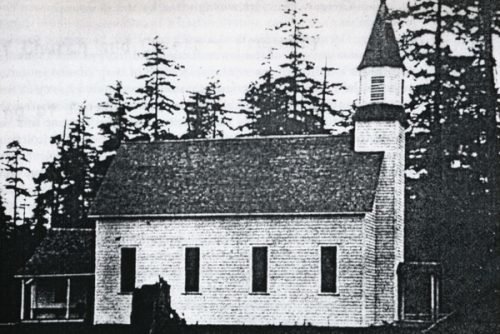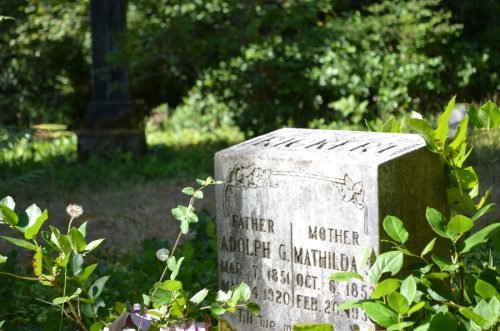 The Evangelical Lutheran Church of the Holy Trinity was built in 1890. It was burned down in 1971 as one of a string of unsolved KP arsons. Courtesy KP Historical Society
The Evangelical Lutheran Church of the Holy Trinity was built in 1890. It was burned down in 1971 as one of a string of unsolved KP arsons. Courtesy KP Historical Society
The German Lutheran Cemetery of Longbranch is off the beaten path, but exploration reveals a story of immigration, faith, pride and prejudice in the melting pot of America.
Like many waves of hopeful migrants to the United States, German immigrants were not eagerly accepted into late 19th century American society. Frequently mocked in their new country, newcomers found in the Key Peninsula a familiar landscape and enjoyed easy fellowship with other German speakers. Eager to build a church of their own, its founders took heart in the idea of worshipping God in their native tongue away from public scorn.
“Many German families had abandoned their homeland to escape the hopeless poverty of the lower classes and to save their sons form the Kaiser’s military conscriptions,” according to R.T. Arledge’s 1998 history, “Early Days of the Key Peninsula.”
The Evangelical Lutheran Church of the Holy Trinity was founded in 1889. After meeting in private homes that first year, construction of the church was completed in 1890. Built on 8 donated acres, conveniently located along the main wagon road between Longbranch and Lakebay (now the intersection of 158th Avenue KPS and 24th Street KPS), the gleaming white church with its tall steeple became the landmark of the fledgling community. The acreage allowed plenty of room for a proper cemetery. The church welcomed Scandinavian Lutherans but sermons and hymns were exclusively in German.
Burial rights in the cemetery were at first restricted to parishioners. Later policies permitted burials of other denominations, although sale of the $3 cemetery plots strictly excluded the “unbaptized” and “freethinkers.”
Early church records were written entirely in German. Meticulously translated into English for historic preservation by Arledge, the first few English words appeared in the church records in 1905, written by August Rückert. The language slip may have been inevitable; in a single generation the name of Rückert became Rickert.
Real church growth was restricted by the language they sought to preserve—a regular point of contention between church elders and others more willing to adapt to American culture. Membership dwindled and debts piled up. The final entry in parish records was made in October 1916. Original tombstones are still well maintained. Photo: Lisa Bryan, KP News
Original tombstones are still well maintained. Photo: Lisa Bryan, KP News
The old shell of the church stood neglected for over half a century. The church bell was rumored to have gone to the war effort in World War II. In 1971, the building was destroyed in a string of unsolved arsons that burned several Longbranch homes and the lighthouse on Filucy Bay’s McDermott Point.
Were it not for the tax collectors, the old cemetery might have been forgotten. A longstanding property tax error resulted in the accidental billing of St. Paul’s Lutheran Church in Tacoma and ironically resulted in new life for the small cemetery.
Pastor Wagner of the then new Key Peninsula Lutheran Church received a letter in the early 1980s from St. Paul’s Lutheran Church explaining the situation. Payment of approximately $700 in back taxes was required to save the German Lutheran Cemetery, according to Jim Davis of Longbranch, church member and sexton of the cemetery.
Conflicting accounts remain of who exactly raised the $700 to save the old cemetery, but the money was collected and the debt paid to bring it back under Key Peninsula ownership. A nonprofit association was formed to govern the cemetery in a cooperative joint venture between remaining descendants and the KP Lutheran Church. The property was logged and $18,000 from the timber sale, coupled with sales of new plots, fund continued cemetery maintenance and upkeep.
The late Ross Bischoff, a member of the Lutheran Church who died in 2008, initially took on the cemetery as one of his many community projects and is now buried there alongside his parents and wife, Joyce, who preceded him in death.
“After Ross died, the cemetery association needed some rejuvenation,” Davis said. “We fenced the roadside, installed a gate and have focused our attention and labor on trying to make it look decent,” he said.
“The cemetery association decided no further burials will take place in the historic portion of the cemetery, to honor those early pioneers,” Davis said. “Numerous plots are available for purchase by residents of the Key Peninsula at $200 each, regardless of religious preference. We plan to be here a long time.”
For more information, see “Early Days of the Key Peninsula” by R.T. Arledge, KP Historical Society, 1998.
UNDERWRITTEN BY THE FUND FOR NONPROFIT NEWS (NEWSMATCH) AT THE MIAMI FOUNDATION, THE ANGEL GUILD, ADVERTISERS, DONORS AND PEOPLE WHO SUPPORT INDEPENDENT, NONPROFIT LOCAL NEWS